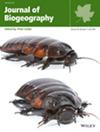Tropical Biome Switching: Ant Communities Transition From Savanna to Rainforest Following Cessation of Burning
Abstract
Savannas and rainforests co-occur as mosaics across large areas of the tropics. These mosaics are dynamic, with savanna and rainforest switching in relatively short time scales, largely through the effects of fire. Most research to date addresses such biome switching through the lens of vegetation, with little attention given to faunal responses to transitions between savannas and rainforests.
Aim
To assess the responses of ant communities to biome switching from savanna to rainforest following 50 years of fire cessation.
Location
Iron Range (Kutini-Payamu) on Australia's Cape York Peninsula.
Taxon
Subterranean, leaf litter, epigaeic, and arboreal ant assemblages.
Methods
We sampled ant assemblages using pitfall, subterranean and arboreal traps and leaf litter extractions across different vegetation types: savanna, secondary forest, primary dry forest and primary wet forest.
Results
The ant fauna was highly stratified, with distinct subterranean, leaf-litter, epigaeic and arboreal assemblages. Ant communities in secondary forest were more similar to that in primary forest than in savanna. However, the secondary forest is still missing a range of specialist forest taxa, especially cryptobiotic species from the soil and leaf litter. The status of specialist canopy species remains unknown.
Main Conclusions
Despite low similarity in floristic composition due to a poor representation of primary rainforest trees in secondary forest, we find a clear switch from savanna to rainforest ant communities after 50 years of fire cessation. Even though full recovery of rainforest ant communities has not occurred, the current 50 year-old secondary forest has much of the ant biodiversity value of primary rainforest, including for regionally endemic species that are rainforest specialists. This provides further evidence that ant communities respond more strongly to vegetation structure than to floristic composition.


 求助内容:
求助内容: 应助结果提醒方式:
应助结果提醒方式:


